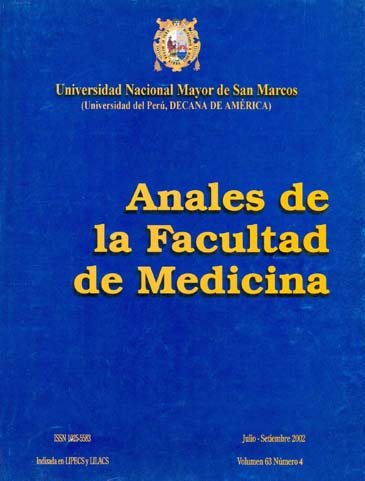STD/HIV risk perception and behaviour in adolescent women inscribed to obtain military identification card at Lima and Callao 2001
DOI:
https://doi.org/10.15381/anales.v63i4.1506Keywords:
Sexually transmitted diseases, HIV infections, adolescence, sex behavior, acquired inmunodeficiency syndromeAbstract
Objective: To obtain information about sexual transmitted diseases (STD) and human immunodeficiency virus (HIV) behavioral risk factors and perceptions in adolescent women, ages between 16 and 17 years, who subscribed to obtain their military identification card. Design: Randomized anonymous, transversal study done in Lima and Callao during 2001. Material and methods: Auto applied questionnaire that used a structural equation model to conduce a path analysis. Results: Seven hundred and fifty-five adolescent women participated in this study, mean age 16,4±0,49 years, mean age at first sexual intercourse 15,4 years. There were risk behaviors related to STD/HIV/AIDS in the adolescents with reported active sexual life: 35,1% had an occasional sex partner, the proportion of global condom use was low (23,4%) while 16% reported two or more sexual partners in the past year, one third (33%) reported having STD signs and most of them (88,3%) perceived low risk of acquiring STD/HIV/AIDS with their actual sexual life. The use of condom as an AIDS method of prevention was not recognized by 26% of respondents. Conclusions: The findings of low risk perception of STD-HIV and high reference of STD signs point the need to target this population for prevention strategies of STD/HIV/AIDS risk behaviors. The path analysis results highlights the importance of considering both rational (level of information, sexual partners number) and non-rational factors (emotions and perceptions) in developing STD-HIV risk reduction behavior strategies.Downloads
Published
2002-12-30
Issue
Section
Trabajos originales
License
Copyright (c) 2002 DORA BLITCHTEIN-WINICKI, LUIS PAREDES, JORGE CALERO, MARLENE MAGALLANES, ELOISA NÚÑEZ, SILVIA PESSAH, MIGUEL ESCURRA, KENEDY ALVA, ENRIQUE SWEING, MARIBEL GONZÁLES

This work is licensed under a Creative Commons Attribution-NonCommercial-ShareAlike 4.0 International License.
Those authors who have publications with this magazine accept the following terms:
- Authors will retain their copyrights and guarantee the journal the right of first publication of their work, which will be simultaneously subject to Creative Commons Attribution License that allows third parties to share the work as long as its author and its first publication this magazine are indicated.
- Authors may adopt other non-exclusive licensing agreements for the distribution of the version of the published work (eg, deposit it in an institutional electronic file or publish it in a monographic volume) provided that the initial publication in this magazine is indicated.
- Authors are allowed and recommended to disseminate their work over the Internet (eg: in institutional telematic archives or on their website) before and during the submission process, which It can produce interesting exchanges and increase quotes from the published work. (See El efecto del acceso abierto ).
How to Cite
1.
Blitchtein Winicki D, Paredes L, Calero J, Magallanes M, Núñez E, Pessah S, et al. STD/HIV risk perception and behaviour in adolescent women inscribed to obtain military identification card at Lima and Callao 2001. An Fac med [Internet]. 2002 Dec. 30 [cited 2024 Aug. 16];63(4):257-68. Available from: https://revistasinvestigacion.unmsm.edu.pe/index.php/anales/article/view/1506















